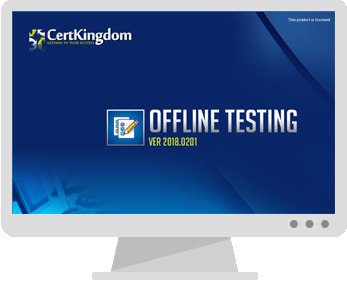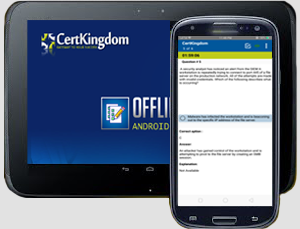Exam: MB7-702

|
|||||||||||||||||||||||||||
Certkingdom's preparation material includes the most excellent features, prepared by the same dedicated experts who have come together to offer an integrated solution. We provide the most excellent and simple method to pass your certification exams on the first attempt "GUARANTEED"
Whether you want to improve your skills, expertise or career growth, with Certkingdom's training and certification resources help you achieve your goals. Our exams files feature hands-on tasks and real-world scenarios; in just a matter of days, you'll be more productive and embracing new technology standards. Our online resources and events enable you to focus on learning just what you want on your timeframe. You get access to every exams files and there continuously update our study materials; these exam updates are supplied free of charge to our valued customers. Get the best MB7-702 exam Training; as you study from our exam-files "Best Materials Great Results"
MB7-702 Exam + Online / Offline and Android Testing Engine & 4500+ other exams included
$50 - $25 (you save $25)
Buy Now
Exam MB7-702
Microsoft Dynamics NAV 2013 C/Side Development
Languages: English, French, German, Spanish
Audiences: IT professionals
Technology: Microsoft Dynamics NAV 2013
Credit toward certification: MCP, MCTS
This Training will Cover
This exam measures your ability to accomplish the technical tasks listed below. The percentages indicate the relative weight of each major topic area on the exam. The higher the percentage, the more questions you are likely to see on that content area on the exam.
Please note that the questions may test on, but will not be limited to, the topics described in the bulleted text.
Describe the data and process models (10-15%)
Explain the table types and characteristics
Explain the characteristics of master tables, supplemental tables, subsidiary tables, ledger tables, register tables, journal tables, document tables, document history tables, and setup tables
Describe the standard data model and process model
Describe the data model diagram, describe standard data flow and typical data triggers
Implement master tables, pages, and documents (10-15%)
Track participants
Develop participant tracking solutions, describe triggers and multi-language support
Manage seminars, instructors, and rooms
Describe seminar management; explain a setup table, master tables, and pages; design seminar management solutions; develop solutions to manage instructors and rooms; create seminar tables and pages
Implement documents
Describe registrations; design a solution for registrations; develop registrations; use objects as text files; describe multi-language functionality in text messages; explain document pages, page functions, virtual tables, temporary tables, and system tables
Describe the table code
Describe seminar registration line table code, the seminar charge table, the seminar comment line table, and pages
Implement posting and dimensions (10-15%)
Explain posting, and develop a posting solution
Describe the journal, ledger, register, tables, and pages; identify journal posting codeunits; explain the journal and document posting processes; describe the example posting routine, existing objects, and code comments; diagnose performance issues; create journal and document posting routines; create and modify codeunits, tables, and pages for a posting solution; complete the journal and ledger tables registration posting; create codeunits and pages for seminar journal posting; create tables and pages for posted registration information; modify tables, pages, and codeunits for resource posting; create codeunits for document posting
Integrate seminar management with dimensions
Choose dimension types, set up dimensions, describe the dimensions data model, design and develop integration of seminar management with dimensions
Implement feature integration and role tailoring (10-15%)
Integrate seminar-management features
Modify tables that contain data, design and develop seminar feature integration
Enable the Navigate feature
Describe Navigate feature architecture, develop solutions for the Navigate feature, integrate objects with the Navigate feature
Explain role tailoring
Describe the RoleTailored user interface, Role Center, actions, ribbon, activities, lists, charts, and profiles
Develop the seminar manager Role Center and department page
Design seminar manager Role Center solutions, develop seminar management department pages
Create and design MenuSuite objects
Describe the fundamentals of the MenuSuite object type, explain the design levels, create and design MenuSuite objects, explain how searching functions by using the Microsoft Dynamics NAV 2013 Windows client
Create reports and manage statistics (10-15%)
Design and create a participant list report
Design and analyze solutions; differentiate between GUI design, functional design, and table design; create seminar participant lists
Develop invoice posting batch jobs
Design and analyze solutions, create invoice posting batch jobs
Manage seminar statistics
Design and analyze solutions, add statistics to the Seminar Management module, create FlowFields of the Sum type, create seminar statistics pages
Implement interfaces and Web Services (10-15%)
Automate email communication with participants
Explain how to implement automation and OCX controls to perform tasks by using other applications, describe file handling functions to import or export data, design and implement email capability
Explain Web Services
Explain Web Services architecture, SOAP Web Services, page operations with SOAP Web Services, extension codeunits, and OData Web Services; handle user interface interactions
Develop a Web Service
Design, develop, and test registration Web Services; create Web Services; create Windows form applications to test Web Services
Test and debug code (10-15%)
Test the seminar management solution
Describe test-driven development fundamentals; test features, codeunits, and functions; explain transaction models for test functions; describe the use of ASSERTERROR in test functions; use handler functions; test pages; create and run a test runner codeunit; design and develop seminar management test solutions; create seminar management unit tests
Debug code
Activate the Microsoft Dynamics NAV Debugger, use breakpoints, run and track code
Optimize for SQL Server (10-15%)
Explain SQL Server integration and database tasks with Microsoft Dynamics NAV
Explain the advantages of using SQL Server for Microsoft Dynamics NAV 2013, describe Microsoft Dynamics NAV tables and indexes in SQL Server, explain how to share data across companies, obtain a list of indexes and their definitions
Use collation, the SQL Server Profiler, and the SQL Server query optimizer
Describe collation, order by sort, describe the value of the SQL Server query optimizer, gather SQL Server statistics, explain SQL Server Profiler terminology
Optimize a Microsoft Dynamics NAV application
Optimize SumIndexField Technology (SIFT) tables and indexes, describe the index usage query, define keys to improve performance, describe implicit and explicit locking, identify problems with NEXT, define suboptimal coding and other performance penalties, analyze index usage, optimize C/AL code
Explain data access redesign
Describe simplified deployment, explain decreased resource consumption, identify caching, describe performance improvements
Describe C/AL database functions and performance on SQL Server
Describe the GET, FIND, NEXT, CALCFIELDS, CALCSUMS, COUNT, SETAUTOCALCFIELDS, INSERT, MODIFY, DELETE, and LOCKTABLE functions; explain dynamic result sets
Describe bulk inserts, locking, blocking, and deadlocks
Describe bulk inserts; identify bulk insert constraints; describe locking, blocking, and deadlocks; explain the benefits of avoiding deadlocks
Describe SIFT data storage in SQL Server
Identify SIFT data storage in SQL Server
Make yourself more valuable in today's competitive computer industry Certkingdom's preparation material includes the most excellent features, prepared by the same dedicated experts who have come together to offer an integrated solution. We provide the most excellent and simple method to pass your Microsoft Microsoft Dynamics Certified Technology Specialist MB7-702 exam on the first attempt "GUARANTEED".
Unlimited Access Package
will prepare you for your exam with guaranteed results, MB7-702 Study Guide. Your exam will download as a single MB7-702 PDF or complete MB7-702 testing engine as well as over +4000 other technical exam PDF and exam engine downloads. Forget buying your prep materials separately at three time the price of our unlimited access plan - skip the MB7-702 audio exams and select the one package that gives it all to you at your discretion: MB7-702 Study Materials featuring the exam engine.
Certkingdom MB7-702 Exam Prepration Tools
Certkingdom Microsoft Microsoft Dynamics Certified Technology Specialist preparation begins and ends with your accomplishing this credential goal. Although you will take each Microsoft Microsoft Dynamics Certified Technology Specialist online test one at a time - each one builds upon the previous. Remember that each Microsoft Microsoft Dynamics Certified Technology Specialist exam paper is built from a common certification foundation.
MB7-702 Exam Testing Engines
Beyond knowing the answer, and actually understanding the MB7-702 test questions puts you one step ahead of the test. Completely understanding a concept and reasoning behind how something works, makes your task second nature. Your MB7-702 quiz will melt in your hands if you know the logic behind the concepts. Any legitimate Microsoft Microsoft Dynamics Certified Technology Specialist prep materials should enforce this style of learning - but you will be hard pressed to find more than a Microsoft Microsoft Dynamics Certified Technology Specialist practice test anywhere other than Certkingdom.
MB7-702 Exam Questions and Answers with Explanation
This is where your Microsoft Microsoft Dynamics Certified Technology Specialist MB7-702 exam prep really takes off, in the testing your knowledge and ability to quickly come up with answers in the MB7-702 online tests. Using Microsoft Dynamics Certified Technology Specialist MB7-702 practice exams is an excellent way to increase response time and queue certain answers to common issues.
MB7-702 Exam Study Guides
All Microsoft Microsoft Dynamics Certified Technology Specialist online tests begin somewhere, and that is what the Microsoft Microsoft Dynamics Certified Technology Specialist training course will do for you: create a foundation to build on. Study guides are essentially a detailed Microsoft Microsoft Dynamics Certified Technology Specialist MB7-702 tutorial and are great introductions to new Microsoft Microsoft Dynamics Certified Technology Specialist training courses as you advance. The content is always relevant, and compound again to make you pass your MB7-702 exams on the first attempt. You will frequently find these MB7-702 PDF files downloadable and can then archive or print them for extra reading or studying on-the-go.
MB7-702 Exam Video Training
For some, this is the best way to get the latest Microsoft Microsoft Dynamics Certified Technology Specialist MB7-702 training. However you decide to learn MB7-702 exam topics is up to you and your learning style. The Certkingdom Microsoft Microsoft Dynamics Certified Technology Specialist products and tools are designed to work well with every learning style. Give us a try and sample our work. You'll be glad you did.
MB7-702 Other Features
* Realistic practice questions just like the ones found on certification exams.
* Each guide is composed from industry leading professionals real Microsoft Microsoft Dynamics Certified Technology Specialistnotes, certifying 100% brain dump free.
* Study guides and exam papers are guaranteed to help you pass on your first attempt or your money back.
* Designed to help you complete your certificate using only
* Delivered in PDF format for easy reading and printing Certkingdom unique CBT MB7-702 will have you dancing the Microsoft Microsoft Dynamics Certified Technology Specialist jig before you know it
* Microsoft Dynamics Certified Technology Specialist MB7-702 prep files are frequently updated to maintain accuracy. Your courses will always be up to date.
Get Microsoft Dynamics Certified Technology Specialist ebooks from Certkingdom which contain real MB7-702 exam questions and answers. You WILL pass your Microsoft Dynamics Certified Technology Specialist exam on the first attempt using only Certkingdom's Microsoft Dynamics Certified Technology Specialist excellent preparation tools and tutorials.
These are real testimonials. Hi friends! CertKingdom.com is No1 in sites coz in $50 I cant believe this but when I purchased the $50 package it was amazing I Microsoft passed 10 Exams using CertKingdom guides in one Month So many thanks to CertKingdom Team , Please continue this offer for next year also. So many Thanks
Mike CA
Thank You! I would just like to thank CertKingdom.com for the Microsoft Microsoft Dynamics Certified Technology Specialist MB7-702 test guide that I bought a couple months ago and I took my test and pass overwhelmingly. I completed the test of 205 questions in about 90 minutes I must say that their Q & A with Explanation are very amazing and easy to learn.
Jay Brunets
After my co-workers found out what I used to pass Microsoft Microsoft Dynamics Certified Technology Specialist MB7-702 the test, that many are thinking about purchasing CertKingdom.com for their Microsoft Dynamics Certified Technology Specialist exams, I know I will again
John NA
I passed the Microsoft Microsoft Dynamics Certified Technology Specialist MB7-702 exam yesterday, and now it's on to security exam. Couldn't have done it with out you. Thanks very much.
Oley R.
Hello Everyone
I Just Passed The Microsoft Microsoft Dynamics Certified Technology Specialist MB7-702 Took 80 to 90 Minutes max to understand and easy to learn. Thanks For Everything Now On To MB7-702
Robert R.
Hi CertKingdom.com thanks so much for your assistance in Microsoft Microsoft Dynamics Certified Technology Specialist i passed today it was a breeze and i couldn't have done it without you. Thanks again
Seymour G.
I have used your Exam Study Guides for preparation for Microsoft Microsoft Dynamics Certified Technology Specialist MB7-702. I also passed all those on the first round. I'm currently preparing for the Microsoft and theMicrosoft Dynamics Certified Technology Specialist. exams
Ken T.
I just wanted to thank you for helping me get myMicrosoft Dynamics Certified Technology Specialist $50 package for all guides is awesome you made the journey a lot easier. I passed every test the first time using your Guide
Mario B.
I take this opportunity to express my appreciation to the authors of CertKingdom.com Microsoft Microsoft Dynamics Certified Technology Specialist test guide. I purchased the MB7-702 soon after my formal hands on training and honestly, my success in the test came out of nowhere but CertKingdom.com. Once again I say thanks
Kris H.
Dear CertKingdom.com team the test no. MB7-702 that i took was very good, I received 880 and could have gain more just by learning your exams
Gil L.
Hi and Thanks I have just passed the Microsoft Dynamics Certified Technology Specialist Directory Services Design exam with a score of 928 thanks to you! The guide was excellent
Edward T.
Great stuff so far....I love this site....!! I am also on the Microsoft Microsoft Dynamics Certified Technology Specialist I decided to start from certkingdom and start learning study Microsoft Dynamics Certified Technology Specialist from home... It has been really difficult but so far I have managed to get through 4 exams....., now currently studying for the more exams.... Have a good day.................................................. Cheers
Ted Hannam
Thanks for your Help, But I have finally downloaded Microsoft Microsoft Dynamics Certified Technology Specialist MB7-702 exam preparation from certkingdom.com they are provided me complete information about the exam, lets hope I get success for the MB7-702 exam, I found there exams very very realistic and useful. thanks again
lindsay Paul
Certkingdom Offline Testing Engine Simulator Download
Prepare with yourself how CertKingdom Offline Exam Simulator it is designed specifically for any exam preparation. It allows you to create, edit, and take practice tests in an environment very similar to an actual exam.
Supported Platforms: Windows-7 64bit or later - EULA | How to Install?
FAQ's: Windows-8 / Windows 10 if you face any issue kinldy uninstall and reinstall the Simulator again.
Download Offline Simulator-Beta
Certkingdom Testing Engine Features
- Certkingdom Testing Engine simulates the real exam environment.
- Interactive Testing Engine Included
- Live Web App Testing Engine
- Offline Downloadable Desktop App Testing Engine
- Testing Engine App for Android
- Testing Engine App for iPhone
- Testing Engine App for iPad
- Working with the Certkingdom Testing Engine is just like taking the real tests, except we also give you the correct answers.
- More importantly, we also give you detailed explanations to ensure you fully understand how and why the answers are correct.
Certkingdom Android Testing Engine Simulator Download
Take your learning mobile android device with all the features as desktop offline testing engine. All android devices are supported.
Supported Platforms: All Android OS EULA
Install the Android Testing Engine from google play store and download the app.ck from certkingdom website android testing engine download

Certkingdom Android Testing Engine Features
- CertKingdom Offline Android Testing Engine
- Make sure to enable Root check in Playstore
- Live Realistic practice tests
- Live Virtual test environment
- Live Practice test environment
- Mark unanswered Q&A
- Free Updates
- Save your tests results
- Re-examine the unanswered Q & A
- Make your own test scenario (settings)
- Just like the real tests: multiple choice questions
- Updated regularly, always current




